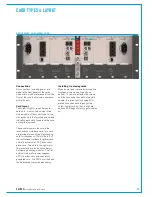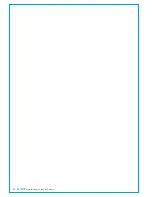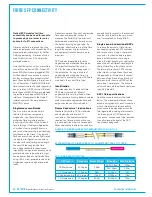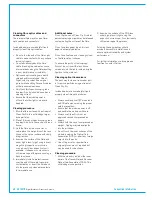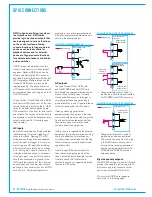
44 ARTEMIS
Digital Broadcast Production Console
Connection Information
Hydra 2 network connections and
control surface to processing core
connections made via copper SFP
modules require shielded F/UTP
Category 5e or Category 6 cables with
shielded RJ45 mating connectors.
Calrec do not supply these cables as it is
often preferable to terminate them after
they have been run through cable ducting
to avoid damaging the terminations, and to
be able to cut them to the precise length
required.
Shieldedcablesandconnectors
Shielded cabling and connectors are
required in order to meet EMC (Electro-
magnetic compatibility) standards to
comply with the radiated emission limits
set in the standard EN55022, as well as
to guarantee performance in electrically
noisy environments.
F/UTP Cat5e/Cat6 cable has an overall
foil shield around the conductor cores.
Shielded RJ45 connector plugs have a
metallic shield around them which should
be clamped / bonded to the shield within
the cable. The shield on the connector
mates with the chassis of the RJ45
socket that it is plugged into, providing an
earth to the cable shield.
The method of attaching the connector
shield to the cable shield can vary. Please
refer to the connector manufacturer’s
information for further guidance.
COPPER SFP CONNECTIVITY
SHIELDED RJ45 CONNECTOR
Conductive connector mating
screen clamped / bonded to
cable shield
Maximumcablelength
The maximum length of Cat5e/Cat6
cables is 90m / 295ft. This is the
absolute maximum and needs to include
any patch points and cables that may be
in the path. Hydra2 cable runs can NOT
be extended using Ethernet switches,
hubs or repeaters. If a run between
Hydra2 hardware exceeds the maximum
recommended distance for copper
cabling, fibre and optical SFPs should be
used instead.
Cableroutingconsiderations
The layout and twist rate of the data cores
within Cat5e/Cat6 cables are integral
to their performance at high speed over
distance. Poor installation practise can
seriously impact upon this. The following
are general good rules of practise,
please refer to the cable manufacturer’s
information for comprehensive installation
rules.
When running Cat5e / Cat6 network
cabling, it is important to avoid kinking
the cable. Kinks can seriously impair
performance. Cable manufacturers
advise that kinked cables should be
discarded and replaced as the damage
caused cannot be addressed simply by
straightening the outer appearance.
Cables should not be bent in tight angles,
this too can seriously impair performance.
Please refer to the cable manufacturer’s
specification on minimum bend radii.
Excessive pulling force when routing
cables can deform the twist rate of the
cable cores, causing irreparable damage.
Cable manufacturers specify a maximum
pulling tension.
Cable-ties should not be over-tightened
as this also deforms the internal structure
of the cable. Cable ties should be tight
enough only to support the cable weight
Crimp points
Cable outer jacket
Strain relief
STRAIN RELIEVED RJ45 TERMINATION
but not so tight as to cause any visible
deformation to the cable’s outer jacket.
Large, heavy bundles of cables can
be difficult to support using cable-ties
without causing damage. 'Velcro' style
hook-and-loop cable straps can be a good
alternative to plastic cable-ties.
Whilst neatly bundled parallel cable runs
are tidy and aesthetically pleasing, they
decrease cross-talk immunity which
can impact on performance. Avoid neat
bundling of network cables over any kind
of distance - the majority of a cables
length is normally unseen, running under
floor or through ducting where they should
be loosely laid rather than neatly bundled.
Termination-strainrelief
Poor termination and lack of strain relief
is one of the most common causes of
high speed network cable problems.
To properly strain relief the data cores,
the outer jacket of the cable should be
inserted into the RJ45 housing and held
in place once crimped by the strain-relief
point, as shown in the following diagram.
This also maintains the integrity of the
twist rate and shield into the termination,
• Note, this is a simplified
diagram that does not
include the shield.
Содержание Artemis
Страница 5: ...calrec com Putting Sound in the Picture ARTEMIS INFORMATION...
Страница 9: ...calrec com Putting Sound in the Picture ARTEMIS CONTROL SURFACE...
Страница 26: ...26 ARTEMIS Digital Broadcast Production Console...
Страница 27: ...calrec com Putting Sound in the Picture ARTEMIS PROCESSING CORE BEAM SHINE...
Страница 33: ...calrec com Putting Sound in the Picture ARTEMIS PROCESSING CORE LIGHT...
Страница 40: ...40 ARTEMIS Digital Broadcast Production Console...
Страница 41: ...calrec com Putting Sound in the Picture ARTEMIS CONNECTION INFORMATION...
Страница 66: ...66 ARTEMIS Digital Broadcast Production Console...
Страница 67: ...calrec com Putting Sound in the Picture ARTEMIS EXTERNAL CONTROL...
Страница 80: ...80 ARTEMIS Digital Broadcast Production Console...
Страница 81: ...calrec com Putting Sound in the Picture ARTEMIS SETUP CONFIGURATION...
Страница 100: ...100 ARTEMIS Digital Broadcast Production Console...
Страница 101: ...calrec com Putting Sound in the Picture ARTEMIS PANEL OPTIONS...
Страница 110: ...110 ARTEMIS Digital Broadcast Production Console...
Страница 111: ...calrec com Putting Sound in the Picture ARTEMIS OBSOLETE PANELS...
Страница 114: ...114 ARTEMIS Digital Broadcast Production Console...
Страница 115: ...calrec com Putting Sound in the Picture ARTEMIS SPECIFICATIONS...






